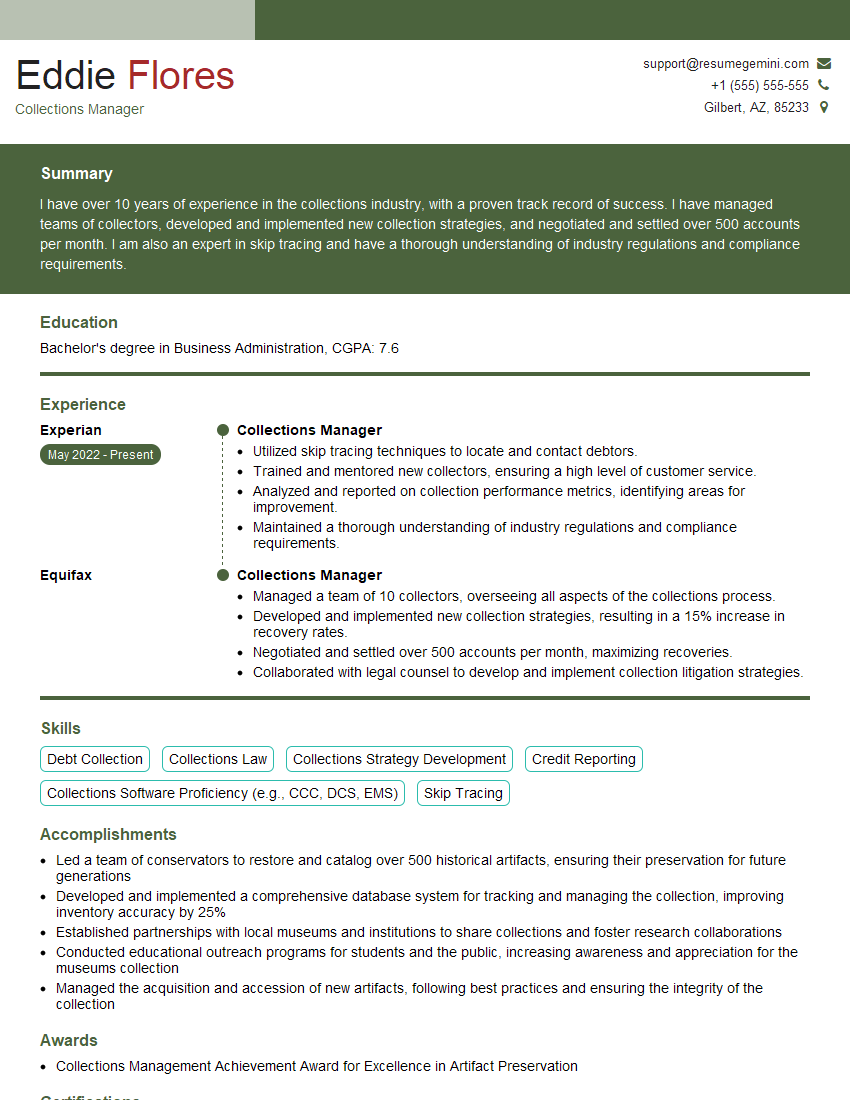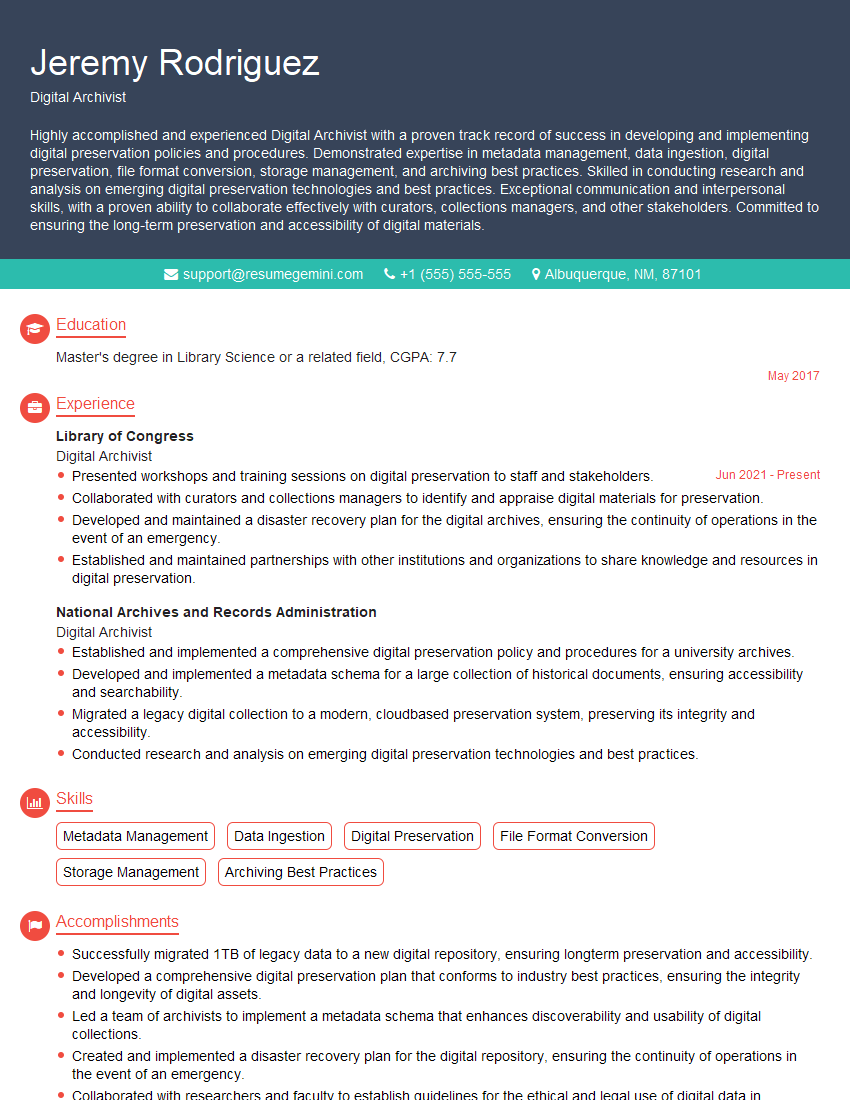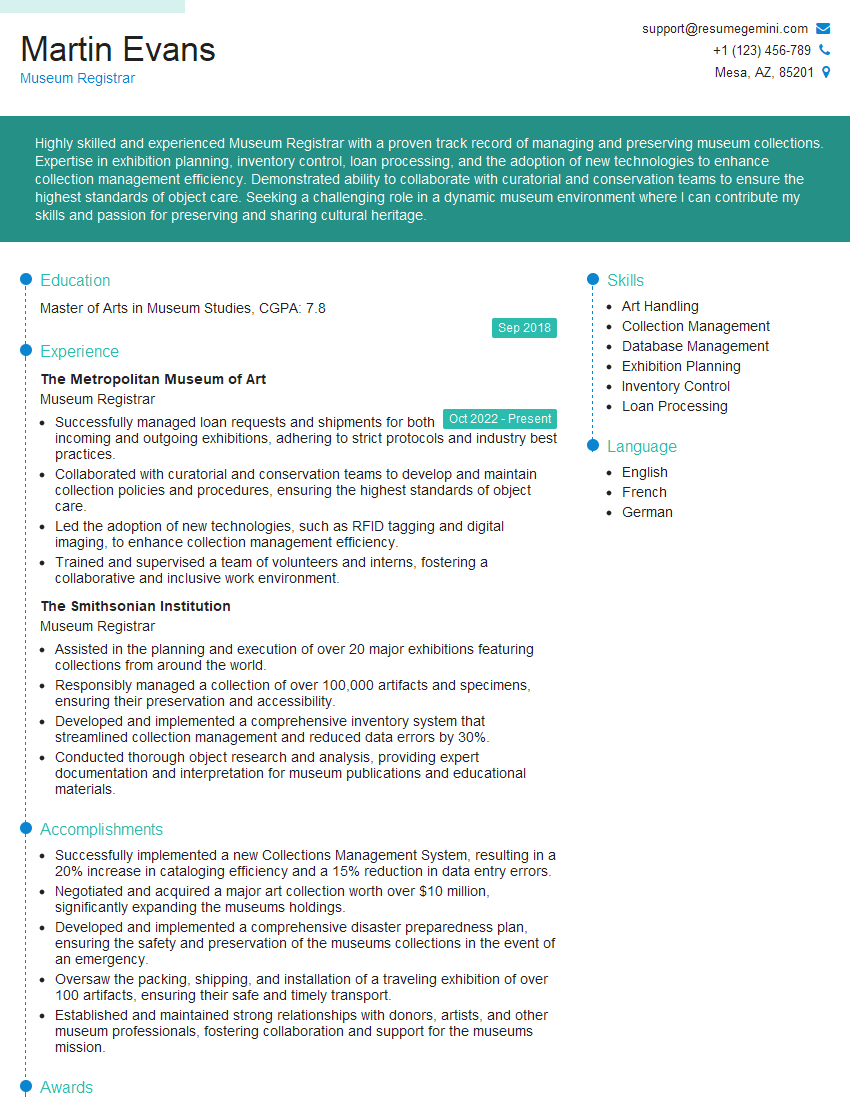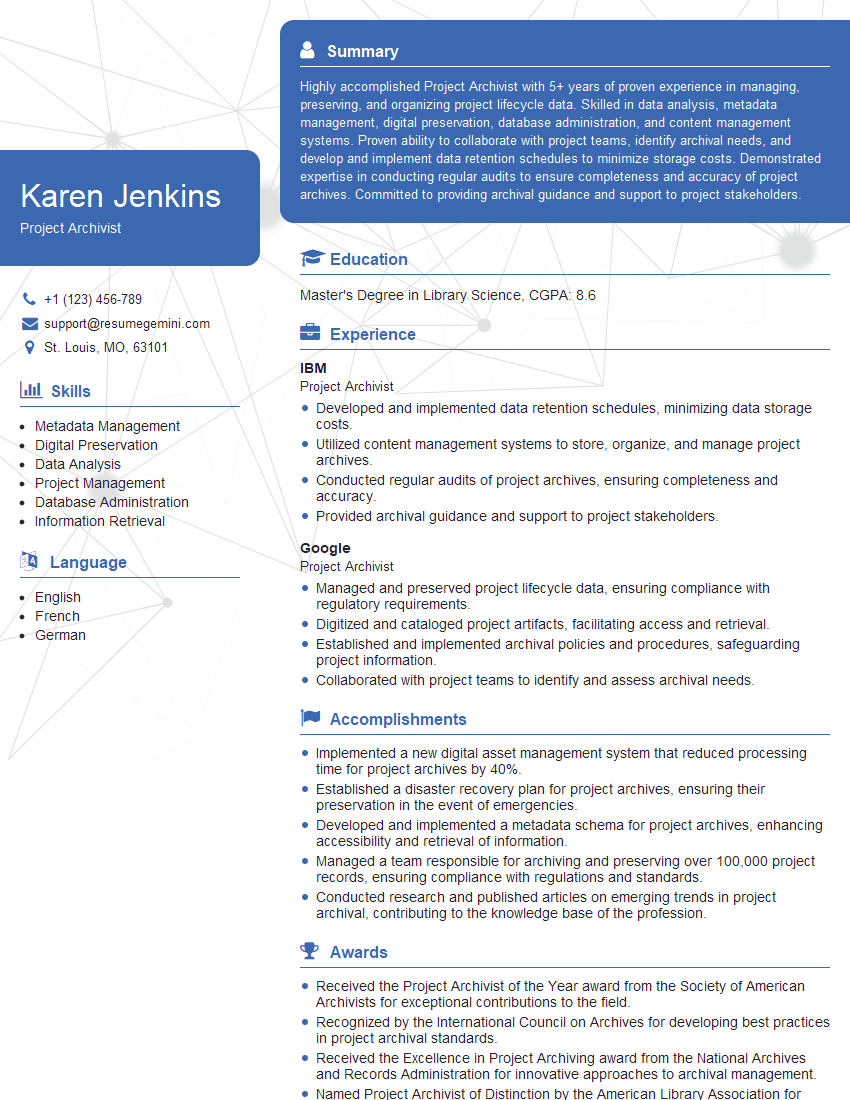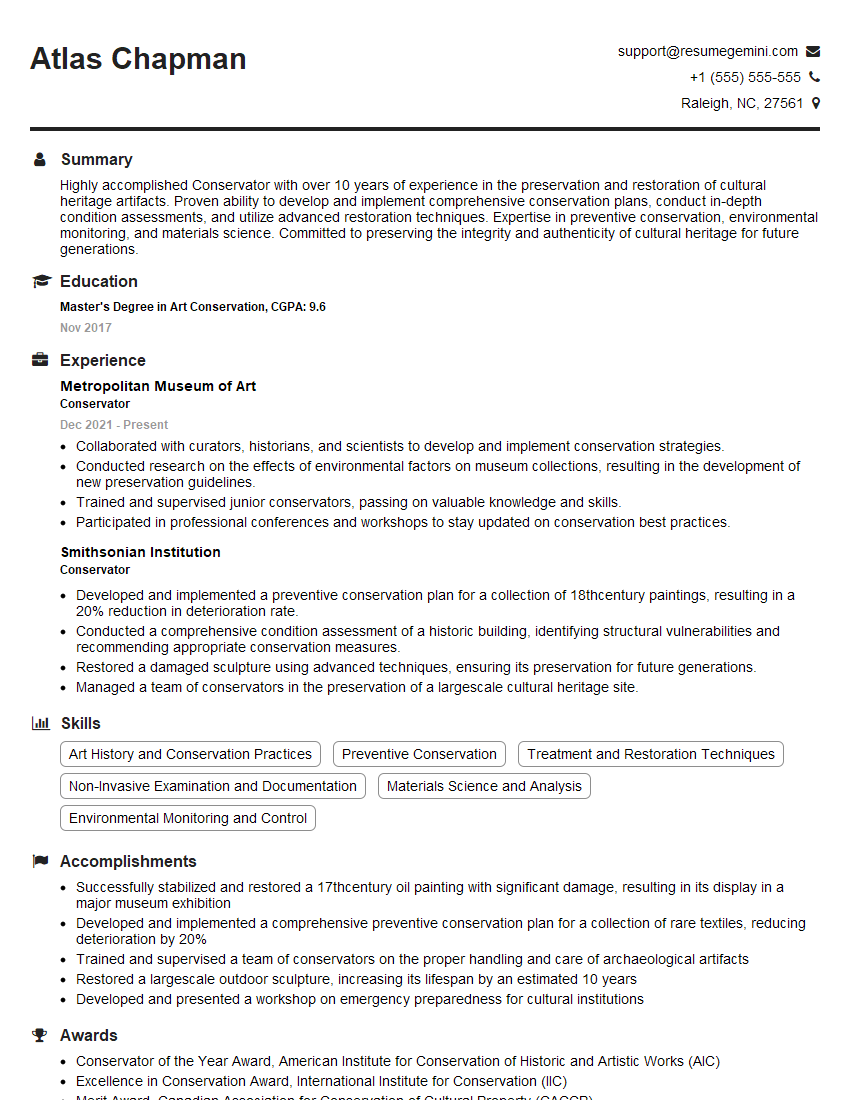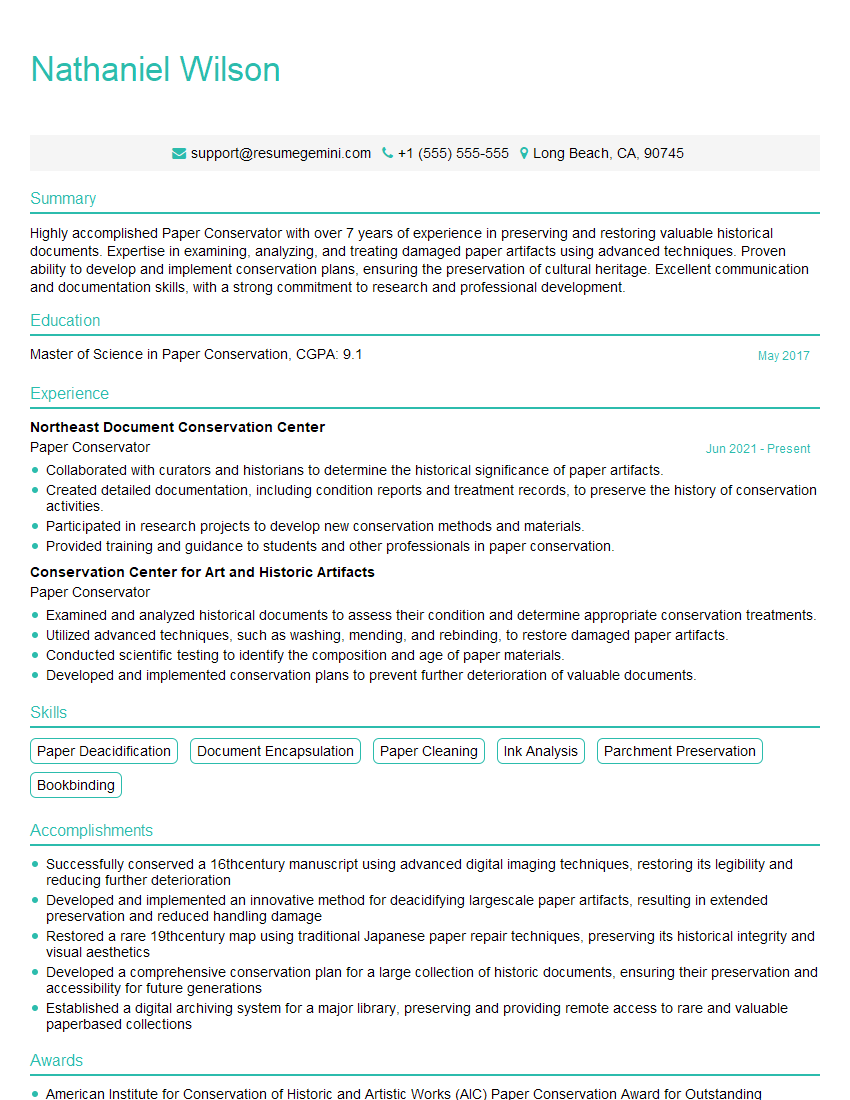Unlock your full potential by mastering the most common Magazine Preservation Techniques interview questions. This blog offers a deep dive into the critical topics, ensuring you’re not only prepared to answer but to excel. With these insights, you’ll approach your interview with clarity and confidence.
Questions Asked in Magazine Preservation Techniques Interview
Q 1. Explain the different types of deterioration affecting magazines.
Magazines, like all paper-based materials, are susceptible to various forms of deterioration. These can be broadly categorized as physical, chemical, and biological.
- Physical Deterioration: This includes damage caused by handling, such as tears, creases, and broken spines. Environmental factors like humidity and temperature fluctuations also contribute, causing warping, shrinking, and embrittlement. Think of how a newspaper becomes brittle over time – that’s a prime example of physical deterioration.
- Chemical Deterioration: This is often invisible at first but insidious. Paper components can undergo oxidation, leading to discoloration (yellowing) and weakening of the fibers. Acidic paper, common in older magazines, accelerates this process. Exposure to pollutants in the air can also contribute to chemical degradation.
- Biological Deterioration: This refers to damage caused by living organisms, such as insects (like silverfish), fungi (mold and mildew), and bacteria. These organisms thrive in humid environments and feed on the cellulose in the paper, leaving holes, discoloration, and unpleasant odors.
Understanding these different types of deterioration is crucial for developing effective preservation strategies. For instance, addressing insect infestation requires different methods than dealing with acid-induced embrittlement.
Q 2. Describe various methods for cleaning and handling fragile magazine pages.
Cleaning and handling fragile magazine pages requires a gentle touch and specialized tools. Avoid harsh chemicals and abrasive materials that can damage the paper further.
- Cleaning: For surface dust, use a soft, natural-bristle brush, gently working in the direction of the paper fibers. For stubborn dirt, consider using a very soft, slightly dampened sponge or a vacuum cleaner with a specialized book attachment. Always test any cleaning method on an inconspicuous area first.
- Handling: Always wear clean cotton gloves to avoid transferring oils and dirt from your hands. Support the pages from underneath when handling to prevent tearing. When turning pages, use your fingertips rather than your nails. For extremely fragile pages, consider using archival-quality tissue paper to gently support them during handling.
- Repairing Minor Tears: Small tears can be repaired with archival-quality tissue paper and wheat starch paste (not PVA glue, which can yellow and damage the paper over time). Always work on a clean, stable surface.
Remember, the goal is to minimize further damage. If you’re unsure about any cleaning or repair, consult a professional conservator.
Q 3. What are the best practices for storing magazines to prevent further degradation?
Proper storage is paramount in preventing further degradation. Think of it as creating a stable, protective microclimate for your magazines.
- Environment: Store magazines in a cool, dry, and well-ventilated area. Avoid direct sunlight, which can cause fading and embrittlement. Ideal temperature is around 68°F (20°C) and relative humidity around 50%. Consider using a hygrometer to monitor humidity levels.
- Storage Containers: Use acid-free boxes or folders made from archival-quality materials. Avoid using plastic containers that can trap moisture and potentially damage the magazines. Each magazine should ideally be housed individually to prevent abrasion.
- Vertical vs. Horizontal Storage: Vertical storage, using shelves or upright boxes, is generally preferred to prevent crushing and warping.
- Pest Control: Regularly inspect magazines for signs of insect infestation. If you find any, take appropriate measures to control the problem – using professional pest control is often the safest option.
By creating a controlled storage environment, you significantly slow down or prevent most forms of deterioration.
Q 4. What are the ethical considerations involved in magazine preservation?
Ethical considerations in magazine preservation are multifaceted. They involve the responsible handling, storage, and access of materials.
- Intellectual Property Rights: Preserving magazines also means respecting copyright and intellectual property rights of authors, publishers, and photographers. Reproducing or sharing copyrighted material without permission is unethical.
- Access and Inclusivity: Preserving materials should ideally enhance access for researchers and the public. Consider methods for making these materials more accessible to diverse user groups (e.g., through digitalization).
- Material Integrity: The preservation process itself should not cause further damage to the materials. The methods chosen must always prioritize the long-term survival and integrity of the magazines.
- Transparency and Documentation: Documenting the condition of magazines before, during, and after preservation is crucial. This enhances transparency and allows future generations to understand the choices made.
Ethical preservation is not only about protecting the physical object but also about upholding intellectual property rights and ensuring equitable access to information and culture.
Q 5. How do you assess the condition of a magazine for preservation needs?
Assessing the condition of a magazine requires a systematic approach. It’s best to use a standardized assessment form.
- Visual Inspection: Begin with a visual assessment, noting any obvious damage such as tears, creases, stains, insect damage, or fading. Note the overall cleanliness and the condition of the binding.
- Material Analysis (Optional): For valuable or historically significant magazines, more in-depth analysis might be necessary. This could involve testing the paper’s pH to determine its acidity level, or using specialized equipment to analyze the paper’s composition.
- Documentation: Document your findings using photos, detailed notes, and a standardized assessment form that records specific details of the condition and damage. This documentation is crucial for tracking the condition over time and informs the preservation plan.
This detailed assessment provides a baseline understanding of the magazine’s condition and guides the selection of appropriate preservation strategies. For complex cases, it is advisable to consult a professional conservator.
Q 6. Explain the process of creating a preservation plan for a collection of magazines.
Creating a preservation plan for a magazine collection requires a structured approach.
- Assessment: Begin by conducting a thorough condition assessment of the entire collection, as described previously. This will identify the materials at greatest risk and guide the prioritization of preservation efforts.
- Prioritization: Based on the assessment, prioritize the magazines that require immediate attention. Consider factors such as historical significance, rarity, and the extent of damage.
- Treatment Decisions: Decide on appropriate treatment strategies for each magazine. This could involve cleaning, repair, rehousing, or digitization. Remember that some interventions might be irreversible.
- Resource Allocation: Determine the necessary resources (time, funding, materials, and expertise) required to implement the preservation plan. Create a timeline and budget.
- Implementation and Monitoring: Implement the plan systematically, monitoring the condition of the magazines regularly and documenting any changes or unforeseen issues.
- Review and Revision: The preservation plan should not be static. Periodically review and revise the plan based on new information, technological advances, or changes in the condition of the magazines.
A well-defined preservation plan ensures the long-term survival of your magazine collection. It acts as a roadmap guiding actions and resource allocation.
Q 7. Describe different types of enclosures and storage materials used for magazine preservation.
Choosing the right enclosures and storage materials is crucial for effective magazine preservation. They should protect the magazines from environmental factors and potential damage.
- Enclosures: Acid-free folders or boxes are essential. These are made from materials that don’t release harmful chemicals, preventing further damage to the magazines. Consider using archival-quality polyester film enclosures for added protection against dust and handling.
- Storage Materials: Acid-free paper, board, and textiles are crucial for the construction of enclosures and supports. Avoid materials containing lignin (wood pulp) or PVC, as these can release damaging chemicals over time. Look for materials that meet the standards set by organizations like the American Institute for Conservation (AIC).
- Special Considerations: For magazines with significant value or fragile pages, specialized enclosures and supports may be needed. This could include custom-made boxes with internal supports or the use of archival-quality foam padding.
Always prioritize archival-quality materials. While they might be more expensive upfront, they offer superior protection and longevity, safeguarding your valuable magazines for generations to come.
Q 8. What are the benefits and drawbacks of digital preservation for magazines?
Digital preservation offers incredible benefits for magazines, primarily accessibility and longevity. Imagine a fragile, century-old magazine; digitally preserving it makes it instantly viewable worldwide, preventing further physical deterioration. We can also easily create searchable indexes and enhance accessibility for visually impaired readers. However, drawbacks exist. The initial digitization process is expensive, requiring high-resolution scanners and skilled personnel. Furthermore, digital formats are susceptible to technological obsolescence. A file format readable today might be unreadable in fifty years, requiring continuous migration and format updates. Finally, ensuring the long-term security and integrity of digital archives needs careful planning and resource allocation. Think of it like this: digital preservation is like saving a photograph; you can create many copies, but each copy needs updating and safeguarding to ensure long-term availability.
Q 9. How do you handle the preservation of magazines with various binding types?
Magazine binding varies greatly, impacting preservation strategies. Saddle-stitched magazines (stapled down the spine) are relatively straightforward; careful handling and appropriate storage prevent spine damage. Perfect-bound magazines (pages glued to a cover) require more attention as the glue can degrade, causing pages to fall out. We often use archival-quality adhesives for repairs. Case-bound magazines (sewn and bound in a hardcover) require expert intervention for significant repairs. For example, a severely damaged spine might need specialized conservation techniques like re-sewing the sections. Each binding type necessitates a customized approach: assessment of the condition, planning appropriate treatment and then selecting storage solutions that minimize further stress.
Q 10. What are the best practices for documenting magazine preservation treatments?
Meticulous documentation is crucial. We use a standardized system combining digital and physical records. Each treatment receives a unique identifier, and we create detailed reports using digital photography and textual descriptions. These records include the magazine’s identification, the treatment procedures employed, materials used (listing their chemical composition and archival stability), and notes on the results. For example, if we repair a tear, we document the tear’s location, size, and the repair technique. Photographs taken before, during, and after treatment help visually track progress and any potential issues. This comprehensive documentation allows for traceability, facilitates future treatments, and aids in researching the effects of different preservation methods. It’s like maintaining a meticulous medical history for each magazine.
Q 11. How do you manage copyright and intellectual property issues related to magazine preservation?
Copyright and intellectual property are paramount. Before undertaking any preservation activity, we rigorously investigate ownership and permissions. We work closely with copyright holders to secure the necessary rights for digitization, reproduction, and public access. Our institution adheres to strict ethical guidelines and legal frameworks. For instance, if a magazine is out of copyright, we proceed with digitization without restriction. However, if copyright exists, we obtain explicit permission before undertaking any action that may infringe on intellectual property rights. We often negotiate licenses for digital reproduction and ensure appropriate attribution in all digital outputs. Transparency and adherence to legal regulations are fundamental to our work.
Q 12. Describe your experience with disaster preparedness and recovery for magazine collections.
Disaster preparedness is crucial. We have developed comprehensive plans addressing various scenarios, including fire, flood, and earthquake. Our collections are stored in climate-controlled environments and secured against unauthorized access. Regular inspections, equipment maintenance, and emergency drills are part of our routine. We’ve developed a detailed evacuation plan that includes the immediate relocation of vulnerable items to a secure offsite location. This also includes detailed inventory and preservation records stored digitally, with backups at multiple locations. Think of it like a layered security system for the magazines; each layer ensures protection from various potential disasters. Our recovery plan outlines the assessment of damages, prioritizing the salvage of at-risk materials, and implementing appropriate conservation procedures.
Q 13. What are the different types of pests that can damage magazines and how do you prevent infestations?
Several pests pose threats, including insects like silverfish, booklice, and beetles, and rodents. Silverfish feed on the starch and glue in paper, leaving characteristic holes. Booklice also consume paper and binding. Beetles bore into the pages, causing significant damage. Rodents can chew through magazines and contaminate them with droppings. Prevention involves integrated pest management. This includes regular inspections, environmental control (maintaining a stable, low-humidity environment), and the use of pheromone traps or targeted pesticide applications only when necessary and strictly adhering to safety guidelines. We also employ preventative measures like vacuuming regularly and storing magazines in acid-free containers and archival boxes to prevent infestation and damage.
Q 14. Explain your understanding of environmental controls for magazine storage.
Environmental controls are critical. Magazines are sensitive to temperature and humidity fluctuations. Excessive heat or humidity can accelerate degradation, leading to embrittlement, discoloration, and mold growth. Conversely, excessively low humidity can also damage them causing brittleness. We maintain stable temperature and relative humidity levels in our storage areas, typically between 65-70°F and 30-40% RH, according to international archival standards. Monitoring tools like hygrometers and thermometers continuously track the environment. This controlled environment is crucial; it’s like keeping magazines in a climate-controlled hibernation, slowing down the aging process and extending their lifespan.
Q 15. Describe your experience with various imaging techniques used in magazine preservation.
My experience with imaging techniques for magazine preservation is extensive, encompassing both traditional and digital methods. For high-resolution capture preserving fine details like ink gradients and paper texture, I rely heavily on high-resolution flatbed scanners, capable of resolutions exceeding 600 dpi. These scanners allow for the creation of digital surrogates which can be used for access and study, reducing the handling of originals. For particularly fragile or oversized magazines, I employ specialized book scanners that use a gently controlled vacuum system to minimize damage during the scanning process. Furthermore, I have experience with multispectral imaging, which captures images across different wavelengths of light to reveal hidden details or information that would be otherwise invisible to the naked eye. This technique is invaluable in assessing the condition of the magazine and detecting hidden damage or alterations. Finally, I incorporate digital image enhancement techniques to improve image quality, and correct for color imbalances, brightness and contrast and distortions caused by age and degradation.
For example, I once used multispectral imaging to reveal a previously unnoticed watermark in a late 19th-century magazine, providing valuable contextual information about its printing origin and history. This highlights the power of advanced imaging techniques beyond simple digitization.
Career Expert Tips:
- Ace those interviews! Prepare effectively by reviewing the Top 50 Most Common Interview Questions on ResumeGemini.
- Navigate your job search with confidence! Explore a wide range of Career Tips on ResumeGemini. Learn about common challenges and recommendations to overcome them.
- Craft the perfect resume! Master the Art of Resume Writing with ResumeGemini’s guide. Showcase your unique qualifications and achievements effectively.
- Don’t miss out on holiday savings! Build your dream resume with ResumeGemini’s ATS optimized templates.
Q 16. How do you select appropriate materials for repairs and restoration of magazines?
Selecting appropriate materials for magazine repair and restoration is crucial for ensuring the long-term preservation of the artifact. The key is to use materials that are chemically stable, inert, and reversible. I avoid materials that might off-gas harmful chemicals or interact negatively with the magazine’s original components. For instance, I always prioritize archival-quality papers, such as Japanese tissue or acid-free papers, for mending tears or filling losses. For adhesives, I carefully select wheat starch paste or methyl cellulose, both known for their reversibility and minimal impact on the original material. The choice of material will depend heavily on the specific material of the magazine itself, its age, and the type of repair being undertaken. For example, a brittle, aged magazine will necessitate more delicate materials and techniques than a relatively robust, modern magazine.
I maintain a detailed inventory of all the materials I use, including their chemical composition and archival properties. This inventory, alongside detailed documentation of the repairs undertaken, ensures the reproducibility of treatment and promotes best practices within conservation.
Q 17. What are the common challenges faced in preserving magazines from different eras?
Preserving magazines across different eras presents unique challenges, mainly due to variations in printing technologies and paper composition. Magazines from the early 20th century, for instance, often contain acidic paper which embrittles over time, leading to yellowing, brittleness and disintegration. This is a direct result of the paper making processes used at that time. In contrast, magazines from later periods may suffer from issues related to the degradation of inks and binding glues, which can also lead to page discoloration, bleed through or detachment of pages and covers. Additionally, the presence of dyes, such as those often found in colorful magazine covers, can be problematic, potentially staining adjacent pages. Environmental factors such as fluctuating temperature and humidity also impact all materials and play a significant role in the degradation rates. Moreover, some magazines may contain materials that are now deemed hazardous – requiring careful handling and specialized storage conditions.
For example, I encountered a collection of pulp magazines from the 1930s whose pages were extremely brittle. Using specialized handling techniques and archival-quality repair materials was essential to prevent further damage. Tailoring preservation strategies to account for such era-specific vulnerabilities is crucial for successful long-term preservation.
Q 18. Describe your experience with metadata creation and management for digital magazine archives.
Metadata creation and management are fundamental to making digital magazine archives accessible and usable. I employ a structured metadata schema, typically based on Dublin Core or MODS (Metadata Object Description Schema), to ensure consistency and interoperability. The essential metadata includes title, author, publisher, publication date, subject keywords, and a unique identifier for each item. In addition to descriptive metadata, I also capture technical metadata, such as file format, resolution, and date of digitization. This comprehensive approach supports searchability, organization, and retrieval of digital materials. I use database management systems such as MySQL or PostgreSQL to store and manage metadata, allowing for efficient querying and reporting of the entire collection. The use of controlled vocabularies, and ontologies also helps ensure accuracy and consistency within and across collections.
For example, I meticulously documented the provenance of each magazine in the metadata, including details about its acquisition and any past conservation treatments. This ensures transparency and allows for a thorough understanding of the item’s history. This structured approach ensures the long-term accessibility and value of the digital archive.
Q 19. How do you prioritize preservation efforts for a large collection of magazines?
Prioritizing preservation efforts for a large magazine collection requires a strategic approach. I typically begin by assessing the condition of each item, identifying those most at risk of loss or deterioration. This assessment often involves a combination of visual inspection and environmental monitoring, including temperature and humidity readings. High-risk items, such as those exhibiting significant physical damage or composed of particularly unstable materials, are given priority. Another key factor is the historical or cultural significance of the magazine. Rare or unique items with significant research or scholarly value receive preferential treatment. Furthermore, community interest or demand may factor into the decision-making process. A risk assessment matrix can be used to determine which magazines need the most immediate attention. I also use a tiered preservation strategy. High-risk, high-value items receive immediate attention, while lower-risk items may be preserved using less intensive methods over time, ensuring that resources are effectively allocated, maximizing the impact of preservation efforts.
This systematic approach ensures that limited resources are used most effectively to preserve the most valuable and vulnerable materials.
Q 20. What are the key differences between preventative and remedial conservation methods?
Preventative conservation focuses on mitigating factors that contribute to deterioration before damage occurs, minimizing the need for extensive, potentially invasive, interventions. This primarily involves controlling the environmental conditions (temperature, humidity, light exposure) under which the magazines are stored. Proper handling techniques, such as the use of gloves and supports, and appropriate storage materials (acid-free boxes, etc.) are also crucial aspects of preventative conservation. In essence, it is about creating an environment conducive to long-term stability.
Remedial conservation, on the other hand, involves direct intervention to repair existing damage. This may include the mending of tears, the cleaning of stains, or the stabilization of brittle paper. Remedial conservation is often more time-consuming and resource-intensive than preventative methods and should be undertaken only when necessary. The goal is to stabilize the item and mitigate further deterioration, while being mindful of reversibility and avoiding damaging interventions. A successful preservation program emphasizes a proactive preventative strategy that minimizes the need for extensive remedial measures. The two approaches work in tandem for optimal preservation.
Q 21. Explain your familiarity with relevant professional standards and guidelines (e.g., AIC, UNESCO).
My work adheres closely to internationally recognized professional standards and guidelines, primarily those established by the American Institute for Conservation (AIC) and UNESCO. The AIC’s Code of Ethics guides my professional conduct, ensuring ethical and responsible handling of materials. I follow AIC’s recommended best practices for environmental controls, materials selection, and documentation of treatments. Moreover, UNESCO’s guidelines on the preservation of documentary heritage inform my approach to digital preservation, emphasizing the importance of long-term accessibility, interoperability, and sustainability of digital archives. I stay updated on the latest standards and guidelines through professional development and participation in relevant conferences and workshops. This continued education ensures that my work remains at the forefront of best practices in magazine preservation, ensuring the long-term survival of this valuable cultural heritage.
Understanding and applying these guidelines not only protects the magazine collections but also ensures the work is credible and contributes to the broader field of archival science.
Q 22. Describe your experience using specialized preservation equipment.
My experience with specialized preservation equipment is extensive. I’ve worked with everything from basic archival-quality acid-free boxes and folders to sophisticated environmental control systems for storage facilities. For instance, I’ve used freeze dryers to mitigate water damage in particularly delicate magazines. This process carefully removes moisture without causing further damage. I’m also proficient in using specialized imaging equipment for high-resolution digital preservation, creating backups of the visual content. Another key tool is the use of dehumidifiers and climate-controlled spaces to maintain a stable RH (relative humidity) and temperature, minimizing degradation from fluctuating conditions. This is crucial, as changes in humidity can cause paper to expand and contract, leading to cracking and warping.
Furthermore, my experience extends to the use of sophisticated cleaning tools, such as HEPA filtered vacuums for removing surface dust and dirt without causing further abrasion to the magazine’s surface. The choice of equipment always depends on the specific condition of the magazine and the preservation goals.
Q 23. How do you assess the cost-effectiveness of different preservation methods?
Assessing the cost-effectiveness of different preservation methods requires a careful balancing act. It’s not simply about the upfront cost of materials or equipment. We must consider the long-term benefits and potential risks. For example, while mass digitization might seem expensive initially, it can be incredibly cost-effective in the long run by preventing further deterioration of the physical copies and allowing for easier access and sharing of the content. Conversely, while encapsulating individual magazines in Mylar might seem inexpensive, the cumulative cost for a large collection can become substantial.
My approach involves creating a detailed cost-benefit analysis for each method, factoring in:
- Initial costs: Materials, equipment, labor.
- Long-term costs: Ongoing maintenance, storage, potential for future repair or remediation.
- Risk assessment: The likelihood of further degradation using a particular method. For instance, improper encapsulation can trap moisture, leading to mold growth.
- Preservation goals: The desired lifespan of the collection and the level of access needed. Digital preservation may be preferable for frequently accessed magazines.
Ultimately, the most cost-effective method is the one that best balances preservation quality with budget constraints while ensuring the long-term viability of the collection.
Q 24. What are the common signs of water damage in magazines and how do you address it?
Water damage in magazines manifests in several ways. The most obvious sign is discoloration, often appearing as dark, water-stained patches. The paper may also be warped, curled, or softened due to the absorption of moisture. Sometimes, you’ll see evidence of mold or mildew growth, a serious indicator of prolonged exposure to water. Buckling, cockling, and rippling are also characteristic signs. Furthermore, the print itself may be smeared or faded due to water damage.
Addressing water damage requires a multi-step approach, starting with immediate action to prevent further deterioration. This may involve carefully removing the magazine from a damp environment and allowing it to air dry slowly, ideally in a controlled environment with low humidity and temperature. More significant damage may necessitate freeze-drying, as mentioned earlier. For mold remediation, professional help is often crucial, employing specialized cleaning techniques and biocides, ensuring to handle such materials properly. In some cases, where the damage is irreparable, high-resolution digital imaging becomes critical to preserve the content.
Q 25. How do you handle the preservation of magazines with valuable or fragile inserts?
Preserving magazines with valuable or fragile inserts, such as posters, postcards, or photographs, requires extra care and attention. The primary goal is to minimize the risk of damage during handling, storage, and any necessary preservation treatments. The inserts should be individually assessed for their condition and material composition before any treatment.
My strategy involves several key steps:
- Careful documentation: Photographing inserts before and after any intervention.
- Individual encapsulation: Each insert may require separate acid-free encapsulation using Mylar or other appropriate materials. This protects them from further damage and prevents abrasion against other elements of the magazine.
- Custom-designed enclosures: The magazine may need a specially constructed box or folder that accommodates the inserts without placing undue pressure on them.
- Support materials: If an insert is especially fragile, archival-quality tissue paper or other inert supports can be used to provide cushioning.
The overall approach emphasizes the preservation of the insert’s integrity and its relationship with the host magazine, aiming for both preservation and appropriate display (where relevant).
Q 26. Describe your experience with the long-term storage and management of magazine archives.
Long-term storage and management of magazine archives requires a strategic, proactive approach. It’s not just about putting them in a box and forgetting them. I’ve been involved in the design and implementation of several archival storage facilities. These typically involve climate-controlled environments with specific humidity and temperature ranges to minimize deterioration. Proper shelving systems are also critical. The use of acid-free materials for storage boxes and shelving is essential.
A crucial aspect is establishing a robust cataloging and inventory system. This allows for easy retrieval and tracking of specific magazines, crucial for researchers and other users. I advocate for using digital databases that are both easily searchable and updatable. Regular inspections are also necessary to detect any potential problems early on, such as pest infestations or unexpected environmental changes. This proactive management approach extends the lifespan of the archive and ensures its accessibility for future generations.
Q 27. How do you collaborate effectively with other professionals involved in preservation projects?
Effective collaboration is paramount in preservation projects. It involves clear communication, shared goals, and a respect for different expertise. In my experience, successful collaborations often involve:
- Regular meetings: Sharing progress, addressing challenges, and coordinating efforts.
- Defined roles and responsibilities: Each team member understands their contribution.
- Shared documentation: Keeping records of treatments, findings, and decisions ensures transparency and allows others to build upon prior work.
- Open communication: Addressing concerns and resolving conflicts promptly.
- Respect for different expertise: Librarians, conservators, archivists, and digitization specialists all contribute unique skills and knowledge.
I often use project management software to track tasks, deadlines, and communication. A well-defined workflow helps keep everyone on the same page and prevents duplication of efforts. The ultimate aim is a collective effort ensuring the best possible outcome for the collection.
Q 28. What are some emerging trends in magazine preservation techniques?
Emerging trends in magazine preservation are heavily influenced by technological advancements. For example, there’s a growing emphasis on digital preservation, moving beyond simple scanning to encompass richer metadata and more sophisticated formats. This means not only creating digital surrogates but also preserving the associated contextual information, such as publication history and associated materials.
Another significant trend is the integration of preventative conservation strategies. This involves creating optimal environmental conditions for storage, employing proper handling techniques, and minimizing exposure to light and pollutants. We are also seeing increased use of innovative materials and techniques for repairing and stabilizing damaged magazines. New materials are being developed that offer enhanced protection against various types of degradation. Finally, there is a significant trend towards open access and collaborative preservation, allowing for more widespread access to digitized collections and greater participation in preservation efforts across institutions.
Key Topics to Learn for Magazine Preservation Techniques Interview
- Environmental Controls: Understanding the impact of temperature, humidity, and light on magazine degradation. Practical application: Designing appropriate storage conditions for long-term preservation.
- Handling and Storage: Proper techniques for handling magazines to minimize damage, including the use of appropriate gloves and supports. Practical application: Developing and implementing a safe handling protocol for a collection.
- Cleaning and Repair Techniques: Methods for cleaning magazines (dusting, vacuuming, surface cleaning) and repairing minor damage (tears, creases). Practical application: Assessing damage and selecting appropriate cleaning and repair methods.
- Material Science: Knowledge of the different materials used in magazine production (paper types, inks, binding methods) and their susceptibility to deterioration. Practical application: Identifying materials and predicting potential degradation pathways.
- Digitization and Preservation: Understanding the role of digital preservation in extending the lifespan of magazine content. Practical application: Evaluating and implementing digitization strategies, including quality control measures.
- Disaster Preparedness and Recovery: Developing plans to protect magazines from damage caused by natural disasters or other unforeseen events. Practical application: Creating and testing emergency response procedures.
- Archival Standards and Best Practices: Familiarity with relevant standards and guidelines for magazine preservation (e.g., Library of Congress guidelines). Practical application: Implementing archival best practices in a professional setting.
- Pest and Mold Control: Recognizing and addressing pest infestations and mold growth that can damage magazine collections. Practical application: Implementing preventative measures and remediation strategies.
Next Steps
Mastering Magazine Preservation Techniques is crucial for a successful career in archives, libraries, museums, and heritage organizations. These skills are highly sought after, leading to diverse and rewarding opportunities. To maximize your job prospects, it’s essential to present your skills and experience effectively through a well-crafted resume. Creating an ATS-friendly resume ensures your application is seen by recruiters and hiring managers. We strongly encourage you to leverage ResumeGemini, a trusted resource for building professional and impactful resumes. ResumeGemini offers examples of resumes tailored specifically to Magazine Preservation Techniques to help you showcase your qualifications effectively.
Explore more articles
Users Rating of Our Blogs
Share Your Experience
We value your feedback! Please rate our content and share your thoughts (optional).
What Readers Say About Our Blog
Hi, I’m Jay, we have a few potential clients that are interested in your services, thought you might be a good fit. I’d love to talk about the details, when do you have time to talk?
Best,
Jay
Founder | CEO
